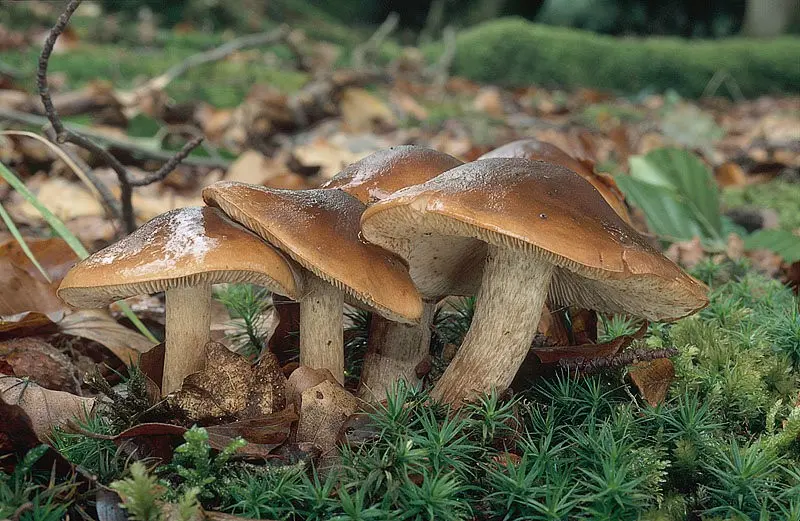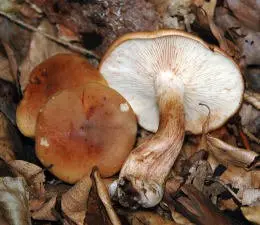Singed rowweed (Tricholoma ustale)
- Division: Basidiomycota (Basidiomycetes)
- Subdivision: Agaricomycotina (Agaricomycetes)
- Class: Agaricomycetes (Agaricomycetes)
- Subclass: Agaricomycetidae (Agaricomycetes)
- Order: Agaricales (Agaric or Lamellar)
- Family: Tricholomataceae (Tricholomovye or Ryadovkovye)
- Genus: Tricholoma (Tricholoma or Ryadovka)
- Type: Tricholoma ustale (Scorched rowweed)
- Ryadovka burnt
- Ryadovka tanned
- Ryadovka burnt
- Ryadovka tanned
- Gyrophila was established

Ryadovka singed is a fungus of the family Ryadovkovy (Tricholomovyh), belonging to the order Agarikovs and the genus Ryadovok.
The main distinguishing features of the scorched row (Tricholoma ustale) are the brown color of the fruiting body, characteristic of both the cap and the stem, the presence of a strong cucumber or mealy aroma, and the reddish color of the hymenophore plates.
The cap of the described mushroom has a diameter of 3-10 cm, in young mushrooms it is convex in shape, often has a tucked edge. Gradually, as the fruiting body matures, the cap becomes flattened. Its surface is often sticky, sticky, characterized by a chestnut-brown tint.
The leg of scorched rows is almost always very thin, has a thin base and noticeable fibrousness. At the base, its color is brown, and at the top – mealy or whitish. When damaged, the flesh of the leg turns a little red.
The hymenophore of the fungus is lamellar, consists of white plates, on the surface of which reddish-brown spots are visible. There are recesses on the plates, with which they often adhere to the surface of the fruiting body. Mushroom spores are characterized by white color, have dimensions of 5-6 * 3-4 microns.
Scorched rows are widespread. You can meet them in mixed forests, mainly in autumn. The fungus of this species is found on the territory of Europe, Asia, North America.
There is no exact information on the edibility of the tanned row (Tricholoma ustale). Many experienced mushroom pickers believe that this mushroom is poisonous and unsuitable for human consumption.
In Japan, the scorched row is considered a poisonous mushroom, since it has been observed that eating it leads to disorders of the gastrointestinal tract, against which a person develops diarrhea or severe vomiting. Japanese populations of scorched rowweed have even been studied in the laboratory, and the results of the procedure showed that the composition of the fruiting bodies contains toxic acids and related compounds that are dangerous to the human body. The experiments were carried out on mice, and as a result of getting this very acid into their bodies in the stomach, the mice experienced spasms and tremors, due to which the animals literally writhed in convulsions.

The main similar species with scorched rowweed is a mushroom called Tricholoma ezcarayense. His description was made in 1992 in Spain. This type of mushroom is distinguished by the presence of flat greenish scales on the surface of the cap, the ability to form deciduous mycorrhiza with deciduous trees (mainly beech). Basically, both types of fungi can be distinguished only by some microscopic features (for example, by the hyphae of the cap cuticle, which in a similar species have more planks).
For the first time, a species of mushroom called scorched row (Tricholoma ustale) was described by the scientist Elias Magnus Fries, who gave his find the name Scorched mushroom. This griyu received its current name only in 1871 from the scientist Paul Kumer, who attributed this species to the genus Tricholomov.
The specific name of the singed row in Latin is pronounced as “ustalis”, and in translation means burnt offering. Actually, such a term fully characterizes the color of the fruiting body of these mushrooms. In Japan, tanned rows are called kaki-shimeji, and the popular name for mushrooms of this species sounds like “Weary Knight”.









